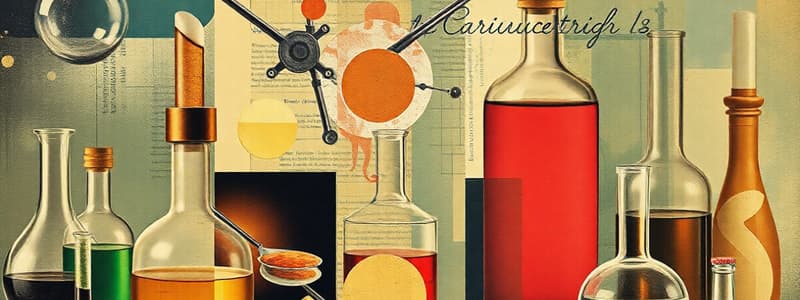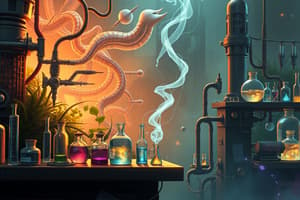Podcast
Questions and Answers
What is the primary difference between accuracy and precision in measurements?
What is the primary difference between accuracy and precision in measurements?
- Accuracy and precision are synonymous terms used interchangeably in measurements.
- Accuracy refers to repeated measurements, while precision is about a single measurement.
- Accuracy measures consistency while precision measures closeness to the true value.
- Accuracy is how close measurements are to the true value, whereas precision refers to the consistency of those measurements. (correct)
Which of the following describes the properties of a gas according to the particle/kinetic theory?
Which of the following describes the properties of a gas according to the particle/kinetic theory?
- Particles move freely with high energy and have no fixed shape or volume. (correct)
- Particles are loosely arranged and can flow past one another.
- Particles have fixed positions and maintain a definite volume.
- Particles are tightly packed and vibrate in fixed positions.
What phase change occurs when a liquid transforms into a gas?
What phase change occurs when a liquid transforms into a gas?
- Boiling (correct)
- Condensation
- Freezing
- Sublimation
What is the primary role of safety equipment like goggles in a laboratory setting?
What is the primary role of safety equipment like goggles in a laboratory setting?
What is the definition of a pure substance?
What is the definition of a pure substance?
What does the atomic number of an element represent?
What does the atomic number of an element represent?
What is represented by the nuclide symbol ₆₂C₁₂?
What is represented by the nuclide symbol ₆₂C₁₂?
Which scientist conducted the Gold Leaf Experiment that led to discoveries about atomic structure?
Which scientist conducted the Gold Leaf Experiment that led to discoveries about atomic structure?
Flashcards are hidden until you start studying
Study Notes
Chemistry Definition
- Chemistry is the study of matter, its properties, and how substances interact.
Common Laboratory Apparatus
- Common equipment used in chemistry labs includes beakers, test tubes, Bunsen burners, tongs, and pipettes.
Safety Equipment
- Lab coats protect clothing, goggles protect eyes, gloves handle chemicals, and fume hoods ventilate dangerous fumes.
Accuracy vs Precision
- Accuracy refers to how close a measurement is to the true value, while precision measures the consistency of repeated measurements.
Matter Definition
- Matter is anything that has mass and volume.
States of Matter
- Solids have a definite shape and volume.
- Liquids have a definite volume but take the shape of their container.
- Gases have no fixed shape or volume and expand to fill their container.
Particle/Kinetic Theory
- The Particle Theory explains the properties of states of matter based on the arrangement and movement of particles.
- Solids have tightly packed particles that vibrate in place.
- Liquids have looser particles that can flow.
- Gases have particles that move freely with high energy.
Properties by Particle Theory
- Solids are rigid due to tightly packed particles.
- Liquids flow due to looser particles.
- Gases can expand and compress due to freely moving particles.
Changes of State
- Melting is the process of a solid changing to a liquid, requiring energy gain.
- Freezing is the process of a liquid changing to a solid, requiring energy loss.
- Evaporation and boiling are processes where a liquid changes to a gas, requiring energy gain.
Heating and Cooling Curves
- Heating and cooling curves show the temperature changes during phase transitions.
- Plateaus on the curve represent phase changes.
Pure Substances
- Pure substances have fixed melting and boiling points.
- For example, water melts at 0°C and boils at 100°C.
Atoms, Elements, Compounds, Mixtures
- An atom is the smallest unit of matter. For example, a hydrogen atom (H).
- An element is made up of one type of atom. For example, oxygen gas (O₂).
- A compound is formed when two or more elements are chemically combined. For example, water (H₂O).
- A mixture is a physical blend of substances. For example, air.
Subatomic Particles
- Protons have a +1 charge, a mass of 1 atomic mass unit (amu), and reside in the nucleus of the atom.
- Neutrons have a neutral charge, a mass of 1 amu, and also reside in the nucleus.
- Electrons have a -1 charge, a negligible mass, and orbit the nucleus.
Particle Diagrams
- Particle diagrams show the arrangement of atoms, compounds, and mixtures.
- Atoms are represented individually, compounds are shown with atoms joined together, and mixtures have separate particles.
Atomic Structure Discoveries
- Key scientists who contributed to understanding atomic structure include Dalton, Thomson, Rutherford, and Bohr.
Gold Leaf Experiment
- Rutherford's Gold Leaf Experiment proved that atoms have a dense, positively charged nucleus.
Mass Number/Atomic Number
- The mass number is the total number of protons and neutrons in an atom.
- The atomic number is the number of protons in an atom.
Nuclide Symbol
- The nuclide symbol represents a specific atom, including its mass number and atomic number.
- For example, ₆²C₆²C represents Carbon-12, with 6 protons, 6 neutrons, and 6 electrons.
Nuclide Diagram
- To draw a nuclide diagram, label the nucleus with the number of protons and neutrons.
- Show the electrons in their appropriate orbitals.
Electron Configuration (First 20 Elements)
- Electron configuration describes the arrangement of electrons in energy levels around the nucleus.
- For example, hydrogen has 1 electron in the first energy level, carbon has 2 electrons in the first level and 4 in the second, and neon has 2 electrons in the first level and 8 in the second.
Lewis Structures
- Lewis structures use dots to represent valence electrons, which are electrons in the outermost energy level, for the first 20 elements.
Isotopes
- Isotopes are atoms of the same element that have different numbers of neutrons.
- For example, Carbon-12 and Carbon-14 are isotopes of carbon.
Uses for Radioactive Isotopes
- Radioactive isotopes have various uses in medicine, such as cancer treatment and diagnosis.
- They are also used in carbon dating.
Relative Atomic Mass (RAM)
- The relative atomic mass (RAM) is the average mass of an element's isotopes, taking into account their abundance in nature.
RAM Calculation
- The RAM is calculated using the following formula:
- (mass₁ × %abundance₁) + (mass₂ × %abundance₂) / 100.
Studying That Suits You
Use AI to generate personalized quizzes and flashcards to suit your learning preferences.




